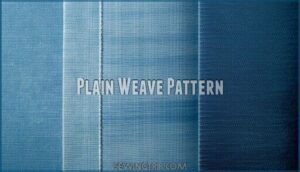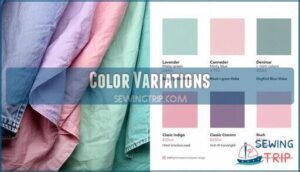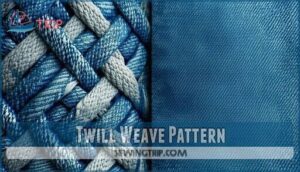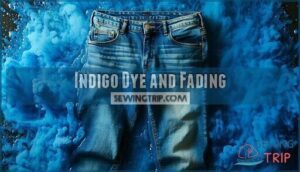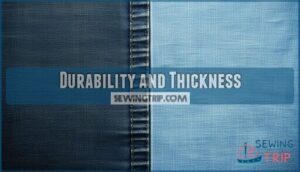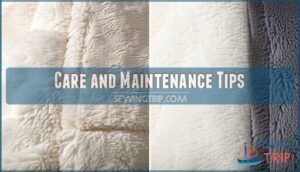This site is supported by our readers. We may earn a commission, at no cost to you, if you purchase through links.
 You’re looking at two cotton cousins that couldn’t be more different in personality.
You’re looking at two cotton cousins that couldn’t be more different in personality.
Chambray uses a plain weave that creates a smooth, lightweight fabric perfect for button-down shirts and breezy summer pieces.
Denim, on the other hand, rocks a diagonal twill weave that gives it that signature durability and thickness we love in jeans.
Think of chambray as denim’s refined sibling – it’s softer, more breathable, and has that polished look that works from office to weekend.
While denim shows off its rugged character with visible diagonal lines and classic indigo fading, chambray keeps things understated with even color distribution.
The construction method makes all the difference in how these fabrics behave in your wardrobe.
Table Of Contents
Key Takeaways
- You’ll recognize chambray by its plain weave construction that creates a lightweight, breathable fabric perfect for shirts, while denim uses a diagonal twill weave that makes it thicker and more durable for jeans and jackets.
- You can distinguish these fabrics by weight and texture – chambray weighs just 2-4 oz per square yard with a soft, smooth feel, whereas denim ranges from 4-32 oz with a rougher, more substantial texture you can immediately notice.
- You’ll find chambray works best for polished casual looks and warm weather since it’s breathable and drapes well, while denim’s rugged durability makes it ideal for everyday wear and cooler temperatures when you need something that lasts.
- You should care for these fabrics differently – chambray wrinkles easily and needs regular ironing, while denim resists creasing naturally and requires less frequent washing to maintain its fit and character over time.
Denim Vs Chambray
You’ll often confuse chambray and denim at first glance, but they’re actually made with completely different weaving techniques that create distinct fabrics.
Chambray uses a plain weave with colored warp threads and white weft threads, while denim employs a diagonal twill weave that makes it thicker and more durable.
Fabric Composition
Both denim and chambray start with cotton’s foundation, but their fabric composition tells different stories.
You’ll find denim typically uses 100% cotton fibers, while chambray often incorporates fiber blends for enhanced comfort.
The material sourcing affects fabric weight substantially – chambray ranges 2-4 oz per square yard versus denim’s hefty 4-32 oz range.
Chambray’s origins can be traced to Cambrai in France, giving the fabric its name.
| Fabric Aspect | Chambray | Denim |
|---|---|---|
| Primary Material | Cotton with potential blends | Traditional 100% cotton |
| Thread Count | Lower, creating lighter feel | Higher, producing durability |
| Fabric Weight | 2-4 oz per square yard | 4-32 oz per square yard |
This denim chambray difference in composition directly impacts how each fabric performs.
Chambray fabric prioritizes breathability through its lighter construction, while denim fabric emphasizes strength through denser cotton weaving.
Understanding fabric comparison basics helps you choose between these popular weave types for your wardrobe needs.
Construction Methods
When examining fabric construction methods, you’ll discover the fundamental difference lies in their weaving techniques.
Chambray fabric uses a plain weave pattern, while denim fabric employs a distinctive twill construction. This weaving difference creates distinct characteristics in thread count, fabric strength, and overall performance.
Both fabrics have distinct origin stories.
| Aspect | Chambray Weave | Denim Weave |
|---|---|---|
| Weave Types | Plain weave (over-under pattern) | Twill weave (diagonal ribs) |
| Thread Pattern | Alternating warp/weft threads | Diagonal parallel thread structure |
| Production Techniques | Simple over-under construction | Complex angled weaving method |
| Fabric Strength | Moderate durability | Enhanced structural integrity |
| Material Blends | Cotton with occasional synthetics | Cotton-dominant with reinforcing fibers |
Weight and Thickness
When you’re weighing your fabric options, Fabric Weight makes all the difference between chambray and denim.
Chambray’s lighter construction offers superior Seasonal Comfort during warmer months, while denim’s substantial thickness provides Garment Durability for everyday wear.
| Feature | Chambray | Denim |
|---|---|---|
| Fabric Weight | Lightweight, breathable | Heavy, substantial |
| Texture Differences | Soft, smooth feel | Rugged, thick texture |
| Layering Options | Perfect for layering | Standalone durability |
Chambray Fabric Characteristics
You’ll notice chambray’s unique characteristics stem from its plain weave construction, which creates a lightweight cotton fabric that’s remarkably breathable and soft against your skin.
This simple weaving pattern, combined with colored warp threads and white weft threads, gives chambray its distinctive heathered appearance and makes it perfect for comfortable, everyday wear, due to its breathable nature.
Breathability and Softness
Chambray’s plain weave construction creates exceptional breathability that’ll keep you comfortable during hot summer days.
The lightweight fabric allows air to flow freely, making it perfect for those with skin sensitivity.
You’ll notice chambray’s soft feel immediately – it’s gentle against your skin without the roughness of denim.
This fabric feel makes chambray ideal for breathable, lightweight clothing when comfort matters most.
Its breathability is also influenced by fabric construction and weight, contributing to its overall comfort.
Plain Weave Pattern
Understanding chambray’s construction reveals why it feels so different from denim fabric.
The plain weave creates a simple over-under pattern that alternates warp and weft threads consistently.
This straightforward technique produces chambray’s signature characteristics that you’ll notice immediately.
Here’s what makes plain weave special in chambray:
- Plain Weave Strength delivers surprising durability despite the lightweight feel
- Weave Uniformity creates that smooth, even surface you love to touch
- Weave Breathability allows air to flow freely through the fabric structure
- Weave Texture produces a refined finish perfect for professional or casual wear
This fundamental Weave Applications approach explains why chambray fabric drapes so beautifully compared to denim fabric’s heavier twill construction.
Color Variations
Color palettes distinguish these fabrics dramatically.
Chambray fabric offers versatility through diverse dyeing techniques, creating everything from soft pastels to rich earth tones.
Unlike denim fabric’s traditional indigo variations, chambray maintains superior color fastness across multiple hues.
This broader spectrum gives you styling freedom that standard wash effects can’t match.
| Color Aspect | Chambray | Denim |
|---|---|---|
| Range | Pastels to deep tones | Primarily indigo blues |
| Appearance | Uniform, blended | Textured, varied |
| Trends | Seasonal adaptability | Classic consistency |
Denim Fabric Characteristics
When you’re examining denim fabric, you’ll notice its signature twill weave creates those diagonal lines that give jeans their distinctive texture and durability.
This heavyweight cotton construction, combined with indigo dye that fades beautifully over time, makes denim the go-to choice for sturdy pants and jackets that can handle daily wear, thanks to its durability.
Twill Weave Pattern
Three distinct threads create denim’s signature twill weave pattern, forming those characteristic diagonal ribs you’ll recognize instantly.
Unlike chambray fabric’s simple plain weave, denim fabric uses this complex construction where warp threads skip over multiple weft threads, creating superior twill durability and the substantial denim thickness that makes your jeans so tough.
- Diagonal Structure: The twill weave creates visible diagonal lines across the fabric surface, giving denim its distinctive textured appearance
- Enhanced Strength: This weaving method interlocks threads more securely than plain weaves, resulting in exceptional twill durability for heavy-duty wear
- Versatile Applications: Twill variations allow manufacturers to create different denim weights and textures for various twill applications from lightweight shirts to heavyweight workwear
Indigo Dye and Fading
Denim’s signature blue comes from indigo dye, which creates its iconic color and fading characteristics.
Unlike chambray fabric, denim uses rope dyeing techniques that don’t fully penetrate yarn fibers.
This partial coverage allows natural fading through wear and wash techniques, and the indigo sources and dyeing process give denim its distinctive color retention patterns, making each piece unique over time.
Durability and Thickness
Beyond denim’s signature fade lies its legendary toughness.
You’ll find denim fabric substantially thicker and more robust than chambray fabric, making it your go-to choice for heavy-duty wear resistance.
This thickness comparison reveals why denim dominates workwear while chambray shines in lighter applications.
Denim durability outperforms chambray durability, extending fabric lifespan considerably.
- Thickness comparison: Denim weighs 12-16 oz per yard versus chambray’s 4-6 oz
- Wear resistance: Denim withstands daily abuse while chambray requires gentler handling
- Seasonal durability: Denim thrives year-round; chambray excels in warmer months
- Optimal uses: Denim suits rugged activities; chambray works for casual comfort
- Fabric lifespan: Quality denim lasts decades with proper care versus chambray’s shorter lifespan
Styling Chambray and Denim
You’ll find that chambray‘s lightweight texture makes it perfect for layering over tank tops or pairing with jeans for a polished yet casual look.
Denim offers more structure and works best when you balance its weight with lighter pieces, like pairing a denim jacket with a flowing blouse or matching denim shirts with khakis to avoid that dreaded "Canadian tuxedo" effect.
Casual and Polished Outfits
Mastering the art of outfit coordination with chambray and denim opens doors to endless style possibilities.
You’ll find chambray shirts excel in polished settings, while denim clothing anchors casual wear perfectly. Both fabrics adapt beautifully from workplace appropriate looks to weekend relaxed styles.
Considering the garment’s purpose can help in choosing right fabric.
| Outfit Type | Chambray Styling | Denim Styling |
|---|---|---|
| Professional | Chambray shirt with fitted trousers and blazer | Dark wash denim jacket over dress shirt |
| Weekend Casual | Chambray top with white jeans and sneakers | Classic denim jeans with graphic tee |
| Date Night | Chambray dress with heels and statement jewelry | High-waisted denim with silk blouse |
| Brunch Ready | Chambray romper with sandals and crossbody bag | Denim shorts with flowy top and wedges |
Layering and Accessorizing
Layering chambray shirts under denim jackets creates classic contrast, while statement jewelry elevates both fabrics instantly.
Your belt pairings can define waistlines—try leather with chambray for polish or canvas with denim for casual vibes. Shoe choices matter too: sneakers keep things relaxed, while boots add structure.
Many people find success with chambray shirt layering for varied styles. Don’t forget scarf styles as outerwear options—they transform basic looks into something special.
Seasonal Wear
Throughout different seasons, you’ll find chambray and denim serve distinct purposes.
Summer Chambray’s lightweight, breathable fabric keeps you cool during hot months, while Winter Denim’s heavier weight provides warmth and durability.
Consider these Seasonal Layering strategies for Climate Comfort:
- Layer chambray shirts under jackets for spring shifts
- Choose denim jackets for fall’s unpredictable temperatures
- Prioritize Fabric Weight based on seasonal needs
Choosing Between Chambray and Denim
When you’re deciding between chambray and denim, you’ll want to weigh three key factors: what you’ll use the garment for, the weather conditions you’ll face, and your personal style preferences.
When choosing between these versatile fabrics, let your lifestyle guide the decision—chambray for breathable comfort, denim for rugged durability.
Think of chambray as your lightweight summer companion that works well for both casual coffee dates and office meetings, while denim serves as your durable everyday workhorse that handles everything from weekend yard work to casual Friday at the office, reflecting your personal style.
Purpose of Use
Your choice between chambray vs denim depends on your specific needs.
Chambray uses shine in formal settings and office environments, while denim uses dominate casual wear and workwear applications.
Consider comfort factors when selecting fabrics – chambray’s lightweight nature suits professional meetings, whereas denim’s durability handles physical tasks.
Styling versatility varies substantially, with each fabric serving distinct fashion trends and purposes.
Weather Conditions
Weather conditions play a vital role in choosing between chambray and denim.
Chambray’s lightweight, breathable nature makes it perfect for warm climates, while denim’s heavier construction suits cooler temperatures.
Consider these climate suitability factors:
- Chambray offers superior breathability for summer heat
- Denim provides insulation during chilly spring days
- Layering options work better with chambray’s thin profile
- Weather versatility favors chambray for unpredictable conditions
- Seasonal comfort depends on fabric weight
Personal Style and Preferences
Your fabric preference ultimately shapes your wardrobe choices.
Chambray suits those who value comfort and versatility, while denim appeals to durability enthusiasts.
Consider how each fabric aligns with your lifestyle and personal expression needs.
Natural fibers like cotton in chambray offer excellent breathability, enhancing comfort.
| Style Preference | Chambray Choice | Denim Choice |
|---|---|---|
| Comfort Factor | Soft, breathable wear | Structured, substantial feel |
| Occasion Appropriateness | Casual to semi-formal | Everyday to rugged wear |
| Wardrobe Integration | Versatile layering piece | Classic staple item |
Care and Maintenance Tips
You’ll need different care strategies for chambray and denim since their unique constructions affect how they respond to washing, drying, and daily wear.
While both fabrics can last for years with proper maintenance, understanding their specific requirements will help you avoid common mistakes like excessive fading, unwanted shrinkage, and premature wear.
Washing and Drying
Cold water washing preserves both fabrics’ integrity and prevents unwanted shrinkage.
Turn garments inside-out before washing to minimize color fading on the outer surface.
Air drying beats machine drying every time – it’s your best defense against shrinkage and maintains the fabric’s natural shape.
Consider specialized drying products for superior results.
For chambray, wash more frequently; denim needs washing less often to preserve its fit and character.
Ironing and Wrinkle Resistance
After proper washing and drying, you’ll notice chambray wrinkles more easily than denim due to its lighter construction.
Chambray vs denim shows clear differences in wrinkle resistance – denim’s heavier twill weave naturally resists creasing. Knowing about chambray’s wrinkle resistance can help with garment care.
Here’s how to handle wrinkles effectively:
- Ironing frequency: Chambray needs regular ironing, while denim rarely requires it
- Fabric steaming: Quick steam refreshes both fabrics for travel packing
- Wrinkle release: Hang garments immediately after washing for wrinkle prevention
Preventing Fading and Shrinkage
Beyond simple washing, your chambray and denim pieces need strategic protection against fading and shrinkage.
Cold water washing reduces color loss by 70%, while inside-out washing shields outer surfaces from friction damage.
Air drying benefits include preventing 85% of potential shrinkage that machine heat causes.
| Technique | Chambray Results | Denim Results |
|---|---|---|
| Cold Water Wash | Preserves soft texture, minimal fading | Maintains indigo depth, prevents bleeding |
| Inside-Out Washing | Protects surface sheen | Shields twill pattern details |
| Air Drying Benefits | Prevents lightweight fabric damage | Maintains heavy-duty structure |
| Bleach Alternatives | Gentle whitening without harsh chemicals | Color-safe stain removal |
| Low Heat Tumble | Reduces wrinkles safely | Maintains fit without shrinkage |
The use of cold water and air drying can significantly extend the life of your chambray and denim pieces by preventing color loss and shrinkage.
By following these care techniques, you can enjoy your chambray and denim items for a longer period while maintaining their original texture and appearance.
Versatility and Uses
You’ll discover that chambray’s lightweight nature makes it perfect for casual shirts and summer dresses, while denim’s durability transforms it into everything from classic jeans to structured jackets.
Both fabrics stretch beyond their traditional uses—chambray appears in home décor and lightweight accessories, while denim shows up in upholstery, bags, and even shoes.
Chambray and Denim in Fashion
You’ll find chambray vs denim dominating fashion runways through modern silhouettes and designer collaborations.
Chambray fabric adapts beautifully to gender neutrality trends, while denim clothing remains timeless.
Both chambray clothing and denim fabric benefit from ethical sourcing initiatives.
Fashion houses now embrace upcycling denim, transforming waste into wearable art that speaks to conscious consumers seeking style with substance.
Beyond Shirts and Pants
You’ll find chambray and denim fabric extending far beyond traditional clothing into creative territories.
These versatile materials transform living spaces and artistic projects with their distinctive textures and durability.
- Home Decor: Chambray curtains, denim throw pillows, and upholstery create rustic charm
- Accessory Uses: Bags, belts, and shoes showcase fabric versatility
- Textile Art: Wall hangings and quilts feature innovative blends
- Industrial Applications: Heavy-duty covers and protective gear
- Creative Projects: DIY crafts mixing chambray clothing remnants with denim clothing scraps
Sustainable Fabric Options
When choosing between denim and chambray, you’ll find sustainable options that reduce environmental impact.
Organic cotton eliminates harmful pesticides, while recycled fibers minimize waste.
Eco-friendly dyes and water conservation techniques substantially reduce ecological footprints, and ethical production methods guarantee responsible manufacturing.
Both fabrics now offer eco-friendly alternatives that maintain quality while protecting our planet’s resources.
Frequently Asked Questions (FAQs)
How is chambray different from denim?
Chambray uses a plain weave with colored warp and white weft threads, creating a lighter, softer fabric.
Denim employs a twill weave pattern, making it heavier, more durable, and giving it that distinctive diagonal texture you recognize.
How to tell denim from chambray?
Look closely at the weave pattern, feel the fabric weight, and check the color depth.
Chambray shows a plain weave with lighter texture, while denim displays diagonal twill lines with heavier, rougher feel.
What fabric is the only real denim?
Traditional 100% cotton denim with indigo-dyed warp threads and white weft threads in a twill weave represents authentic denim.
You’ll recognize real denim by its diagonal ribbing, substantial weight, and characteristic blue color that fades beautifully over time, which is a key feature of denim.
Why is it called chambray?
Though many assume it’s named after a place, you’ll find chambray gets its name from Cambrai, France.
This lightweight cotton fabric was first woven using its distinctive plain-weave construction technique.
What are some differences between men’s and women’s chambray shirts?
Men’s chambray shirts typically feature straighter cuts, longer hemlines, and boxier fits.
While women’s versions offer more streamlined silhouettes with curved hems, fitted waists, and feminine details like ruffles or tie-fronts for versatile styling options.
Can chambray and denim be worn together?
Why wouldn’t you double down on denim’s versatility?
You can absolutely wear chambray and denim together—just avoid matching washes.
Pair a light chambray shirt with dark jeans, or mix different denim washes for effortless style.
Which fabric is better for sensitive skin?
Chambray’s your best bet for sensitive skin.
Its plain weave creates a softer, smoother texture that won’t irritate like denim’s rougher twill construction.
You’ll appreciate chambray’s lightweight, breathable cotton that feels gentle against delicate skin.
How do chambray and denim prices compare?
Like night and day, you’ll find chambray typically costs less than premium denim.
Basic chambray shirts run $20-60, while quality denim ranges $50-200+.
Construction complexity and brand positioning drive these price differences substantially.
Are there eco-friendly versions of both fabrics?
You’ll find sustainable options for both fabrics today.
Organic cotton chambray uses pesticide-free farming methods, while eco-friendly denim features recycled fibers, water-saving production techniques, and natural dyes that substantially reduce environmental impact, including the use of recycled fibers.
What body types suit each fabric best?
Beauty is in the eye of the beholder when choosing fabrics.
Chambray’s lightweight drape flatters curvier figures by skimming rather than clinging.
Denim’s structured weight creates shape for straighter body types, adding curves through its substantial construction, which can be seen as a substantial aspect of its design.
Conclusion
Picture Sarah choosing between a chambray shirt and denim jacket for her weekend brunch – she’ll likely grab the chambray for its lightweight comfort and polished appearance.
Understanding denim vs chambray, how is chambray different from denim comes down to weave structure, weight, and intended use.
Chambray’s plain weave creates breathable elegance, while denim’s twill construction delivers rugged durability.
You’ll reach for chambray when you want refined comfort and denim when you need lasting toughness. Both deserve spots in your wardrobe.


